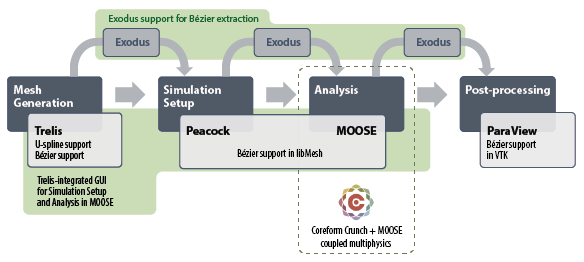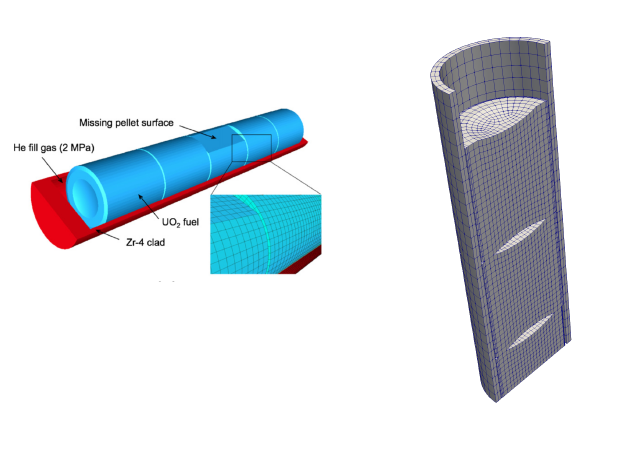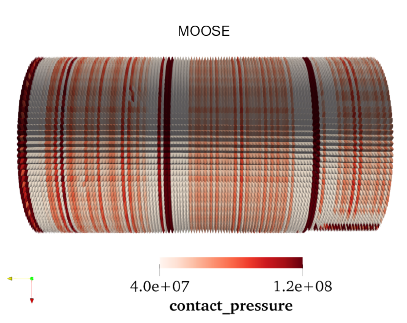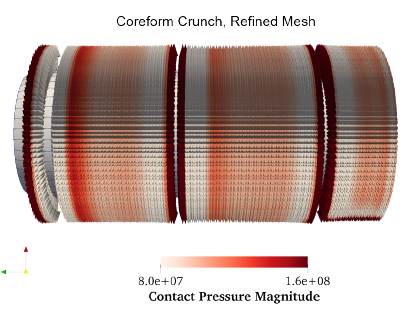
Advancing nuclear energy simulation with Coreform technology
At Coreform we are always looking for opportunities to ensure that our development is informed by real-world industrial challenges.
Since mid-2019, we’ve been fortunate to work with the team at Idaho National Laboratory (INL) to advance nuclear multiphysics simulation and help shape Coreform tools to be fit-for-purpose in relation to nuclear sector demands. We’re excited to have recently earned the opportunity to significantly expand this collaboration, and thought we’d take the occasion to share some of the details. This work is funded by two recently awarded Department of Energy SBIR awards, “Parametric spline “mesh” generation for nuclear engineering”, currently in Phase II, and “Enabling the Broader use of MOOSE for Nuclear Energy and Other Simulation”, currently in Phase I.
Our work with INL centers on their open-source Multiphysics Object-Oriented Simulation Environment (MOOSE), which has become a standard in nuclear energy simulation software, with significant and growing adoption in other industrial applications as well. MOOSE is a powerfully flexible, modular platform that allows tailored construction of multiphysics simulation codes/executables from hundreds of available physics capabilities. It also has exceptional facilities for parallel, flexibly coupled solves between multiple independent codes and external software.
In consultation with the INL team, Coreform has embarked on a multi-project effort to (1) augment MOOSE analysis capabilities with both coupled and native, purpose-critical Coreform spline technology; and (2) provide MOOSE users with streamlined and simplified workflow possibilities. The figure below illustrates project objectives and their relation to the general MOOSE ecosystem.

Here’s what we’ve already accomplished:
Initial foundation for MOOSE to handle spline data
MOOSE runs on the open-source libMesh kernel. Coreform contracted Dr. Roy Stogner of UT-Austin, a key contributor to libMesh, to implement enhancements allowing libMesh to consume data in the Bezier Extraction (.bext) file format, which can encode either Coreform’s patent-pending U-splines technology or non-proprietary spline types, such as NURBS. We confirmed the successful integration by importing a spline-modeled fuel rod into the newly spline-enabled libMesh, then exporting it to Paraview for viewing.
Spline modeling tool built on Trelis
MOOSE users inside the DOE generally use CUBIT to prepare FEA meshes for analysis in MOOSE, and outside the DOE, many MOOSE users use Coreform Trelis, which is basically the commercial version of CUBIT. Coreform is developing parametric spline modeling functionality on top of Trelis. We have used this functionality to create geometrically exact spline meshes of fuel pellets and cylindrical cladding geometries for a proof-of-concept light-water reactor contact simulation.

ABOVE LEFT: Diagram of fuel rod section, illustrating pellet defect problem.
ABOVE RIGHT: U-spline model cross-section view of a cylindrical fuel rod, consisting of fuel pellets surrounded by cladding. With C1 enforced smoothness.
Confirmed superior accuracy of spline-based contact simulation
In a simplified mockup, Coreform tested the putative benefits of spline-based simulation on a contact problem modeling the impact of fuel pellet surface imperfections on fuel and cladding behavior. Our simplified simulation was performed in the beta Coreform Crunch spline-based solver using the spline models built with the Trelis-based parametric tool.
The results were promising. Our spline models (see above) were C1 smooth, used fewer elements, and returned superior results as hypothesized. The irregular patterns in the MOOSE results reflect geometric error from traditional linear FEA meshing. By contrast, spline-based results from Crunch are accurate to the geometric symmetry, showing the expected smoothly varying contact pressures.


TOP: The striations appearing in MOOSE’s contact pressure results reflect the error arising from faceted approximation of smoothly curving geometry.
BOTTOM: Spline-based simulation’s smooth contact gradients accurately reflect the cylindrical pellet and cladding geometries.
Here’s what’s in progress or upcoming:
Trelis-integrated simulation setup for MOOSE
Our most recently inaugurated project is focused on enabling workflows, particularly in relation to simulation setup in the on-the-fly Peacock GUI.
To make the MOOSE experience more accessible, Coreform is currently beginning work on integrating MOOSE preprocessing into our Trelis meshing software. Specifically, we’ll be creating an internal GUI for setting up and performing MOOSE simulation analysis directly from within Trelis. This project will be initially focused on MOOSE’s Tensor Mechanics structural dynamics module, with further functionality possible in the future.
Spline support in Exodus file format
Workflows can’t happen without data flows, and in the case of MOOSE that means making room for spline information in Exodus, MOOSE’s native finite element file format to store and convey both simulation inputs (meshes, loads, materials, and boundary conditions) and outputs (results for postprocessing and visualization). Coreform will add necessary data structures to Exodus in our upcoming project.
Improved libMesh spline support
Building on the already-accomplished work begun last year, we will also be pushing forward support for splines in libMesh, making sure spline data play well with constraints, boundary conditions, and libMesh data structures. We’ll be paying special attention to those libMesh features critical to its inbuilt reduced-order modeling (ROM) capabilities, for which spline bases hold particular promise.
Optimized Crunch-coupled multiphysics with MOOSE
Coreform will leverage MOOSE’s coupling framework to create seamless Crunch-MOOSE multiphysics solving. Coupling Coreform Crunch with MOOSE will combine the strengths of each to enable the simulation of complex nuclear physics in combination with nonlinear structural dynamics phenomena and complex, high-fidelity CAD designs. We believe the result will be to dramatically increase the range of industry problems susceptible to effective simulation analysis, while at the same time rendering it easier to achieve accurate, converged solutions for well-known real-world challenges.
With all of these efforts we are very keen to engage with the MOOSE community, and we welcome your input and feedback! We will share results in this forum as this work continues.
